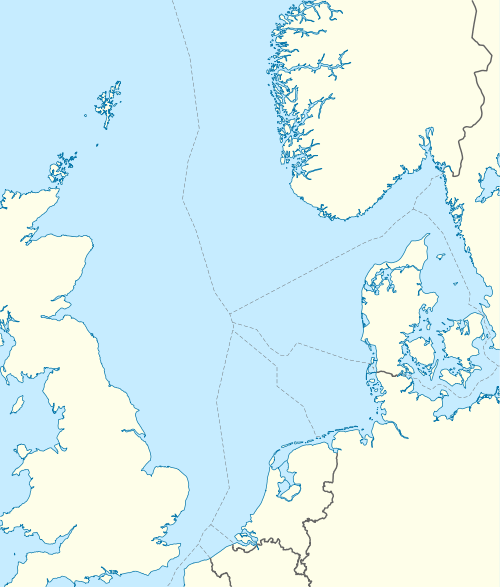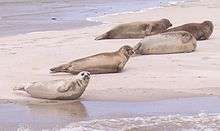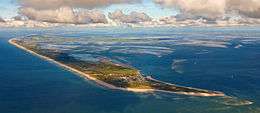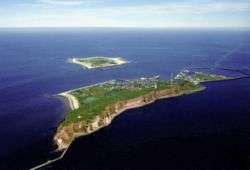Wadden Sea
| UNESCO World Heritage site | |
|---|---|
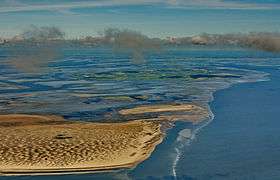 | |
| Location | North Sea in Denmark, Germany and the Netherlands |
| Criteria | Natural: viii, ix, x |
| Reference | 1314 |
| Inscription | 2009 (33rd Session) |
| Extensions | 2014 |
|
Wadden Sea: 1 = Netherlands 2 = Lower Saxon Wadden Sea National Park Germany 3 = Hamburg Wadden Sea National Park, Germany 4 = Schleswig-Holstein Wadden Sea National Park, Germany 5 = Wadden Sea National Park, Denmark | |
The Wadden Sea (Dutch: Waddenzee, German: Wattenmeer, Low German: Wattensee or Waddenzee, Danish: Vadehavet, West Frisian: Waadsee, North Frisian: di Heef) is an intertidal zone in the southeastern part of the North Sea. It lies between the coast of northwestern continental Europe and the range of low-lying Frisian Islands, forming a shallow body of water with tidal flats and wetlands. It is rich in biological diversity. In 2009, the Dutch and German parts of the Wadden Sea were inscribed on UNESCO's World Heritage List and the Danish part was added in June 2014.[1][2]
The Wadden Sea stretches from Den Helder, in the northwest of the Netherlands, past the great river estuaries of Germany to its northern boundary at Skallingen in Denmark along a total coastline of some 500 km (310 mi) and a total area of about 10,000 km2 (3,900 sq mi). Within the Netherlands it is bounded from the IJsselmeer by the Afsluitdijk. The Wadden Sea's coastline has been heavily modified by man. Extensive systems of dikes and causeways make it among the most human-altered on the planet.[3]
The German part of the Wadden Sea was the setting for the 1903 Erskine Childers novel The Riddle of the Sands.
Nature
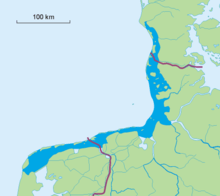
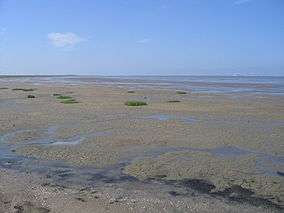
Environment
The word wad is Dutch for "mud flat" (Low German and German: Watt, Danish: Vade). The area is typified by extensive tidal mud flats, deeper tidal trenches (tidal creeks) and the islands that are contained within this, a region continually contested by land and sea.[4]
The landscape has been formed for a great part by storm tides in the 10th to 14th centuries, overflowing and carrying away former peat land behind the coastal dunes. The present islands are a remnant of the former coastal dunes.
Towards the North Sea the islands are marked by dunes and wide sandy beaches, and towards the Wadden Sea a low, tidal coast. The impact of waves and currents carrying away sediments is slowly changing both land masses and coastlines. For example, the islands of Vlieland and Ameland have moved eastwards through the centuries, having lost land on one side and added it on the other.
Fauna
The Wadden Sea is famous for its rich flora and fauna, especially birds. Hundreds of thousands of waders, ducks, and geese use the area as a migration stopover or wintering site. It is also a rich habitat for gulls and terns.[5] However, the biodiversity of Wadden Sea today is only a fraction of what was seen before human exploitation; for birds, larger species such as geese,[6] eagles, flamingos, pelicans, and herons used to be common as well.[7] Some regionally extinct species are still found here.[8][9]
According to J. B. MacKinnon, larger fish including sturgeons, rays,[10] Atlantic salmon, brown trout, and others like lacuna snails and oyster beds that were once found elsewhere in the region have disappeared as the Wadden Sea has been reduced to about 50% of its original size and nutrients from Rhine river no longer flow into it. As a result, about 90% of all the species which historically inhabited the Wadden Sea are present at risk.[11]
Wadden Sea is an important habitat for both harbour and grey seals. Harbour porpoises and Atlantic white-beaked dolphins, which once were locally extinct but have re-colonized the area, are the sea's only resident cetaceans.[12] Many other species have disappeared, only visit seasonally, or occasionally.[13][14][15] North Atlantic right whales and gray whales were once seen in the region, using the shallow, calm waters for either feeding and breeding,[16] before they were completely wiped out by shore-based whaling.[17] They are now thought to either be extinct or have remnant populations In the low-tens. A possible right whale was observed close to beaches on Texel in the West Frisian Islands and off Steenbanken, Schouwen-Duiveland in July 2005.[18] Recent increases in number of North Atlantic humpback whales and minke whales might have resulted in more visits and possible re-colonization by the species to the areas especially around Marsdiep.[19][20] Future recovery of once-extinct local bottlenose dolphins is also expected.[12]
Threats to the ecosystem
A number of human-introduced invasive species, including algae, plants, and smaller organisms, are causing negative effects on native species.[21]
Conservation
Each of three countries has designated Ramsar sites in the region (see Wadden Sea National Parks).
Although the Wadden Sea is not yet listed as a transboundary Ramsar site, a great part of the Wadden Sea is protected in cooperation of all three countries. The governments of the Netherlands, Denmark and Germany have been working together since 1978 on the protection and conservation of the Wadden Sea. Co-operation covers management, monitoring and research, as well as political matters. Furthermore, in 1982, a Joint Declaration on the Protection of the Wadden Sea was agreed upon to co-ordinate activities and measures for the protection of the Wadden Sea. In 1997, a Trilateral Wadden Sea Plan was adopted.[22]
In 1986, the Wadden Sea Area was declared a biosphere reserve by UNESCO.[23]
In June 2009, the Wadden Sea (comprising the Dutch Wadden Sea Conservation Area and the German Wadden Sea National Parks of Lower Saxony and Schleswig-Holstein) was placed on the World Heritage list by UNESCO.[24] The Danish part was added to the site in 2014.
Recreation
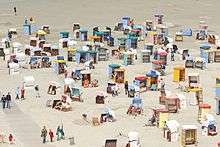
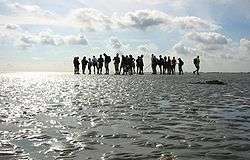
Many of the islands have been popular seaside resorts since the 19th century.
Mudflat hiking, i.e., walking on the sandy flats at low tide, has become popular in the Wadden Sea.[25]
It is also a popular region for pleasure boating.
References
- ↑ Wadden Sea World Heritage Site. Retrieved on 29 April 2010.
- ↑ "Six new sites inscribed on World Heritage List". UNESCO. Retrieved 23 June 2014.
- ↑ C. Michael Hogan (2011). "Wadden Sea". In P. Saundry; C. Cleveland. Encyclopedia of Earth. Washington DC: National Council for Science and the Environment.
- ↑ Scheffel, Richard L.; Wernet, Susan J., eds. (1980). Natural Wonders of the World. United States of America: Reader's Digest Association, Inc. pp. 408–409. ISBN 0-89577-087-3.
- ↑ Couzens, Dominic (2008). Top 100 Birding Sites of the World. University of California Press. pp. 27–29. ISBN 978-0-520-25932-4.
- ↑ http://www.fmap.ca/ramweb/media/biodiversity_loss/downloads/RegionalExtinctionExamples.pdf%5Bpermanent+dead+link%5D
- ↑ Alanna MitchelA., 2009. 6-Reading the vital signs: life force. pp.78. Halifax, Canada-The fate of the fish. Seasick: Ocean Change and the Extinction of Life on Earth. University of Chicago Press. Retrieved on 29 July 2014
- ↑ "Regional Species Extinctions - Examples of regional species extinctions over the last 1000 years and more" (PDF). archive-it.org.
- ↑ Reise K., A natural history of the Wadden Sea. Wadden Sea Station Sylt - AWI. Retrieved on 29 July 2014
- ↑ Cadée C.G., Reise K., 2001. [66 - Changes in Historical Times]. Ecological Comparisons of Sedimentary Shores. pp.141. Ecological Studies, Vol. 151. Springer Science+Business Media. Retrieved on 29 July 2014
- ↑ MacKinnon B.J., 2013. The Nature of Nature. The Once and Future World: Nature as It Was, as It Is, as It Could Be. pp.100. Retrieved on 29 July 2014
- 1 2 Kees (C.J.) Camphuysen. "NZG Marine Mammal Database - Sightings of cetaceans in The Netherlands and the Southern North sea". Retrieved 28 January 2015.
- ↑ metatags generator. "Cetaceans". Archived from the original on 2014-04-05.
- ↑ "Walvisachtigen - Waddenbieb". www.waddenzeeschool.nl.
- ↑ Lotze K.H. (2005). "Radical changes in the Wadden Sea fauna and flora over the last 2,000 years". Helgoland Marine Research. 59: 71. Bibcode:2005HMR....59...71L. doi:10.1007/s10152-004-0208-0.
- ↑ Szaro C.R., Johnston W.D., Wolff. J.W. et al. 1996. Biodiversity of the Wadden Sea. Biodiversity in Managed Landscapes: Theory and Practice. pp.539. Oxford University Press. Retrieved on 29 July 2014
- ↑ Wolff W. J., 2000. The south-east North Sea: losses of vertebrate fauna during the past 2000 years. Biological Conservation 95: 209-21. Retrieved on 29 July 2014
- ↑ Kees (C.J.) Camphuysen. "WHO HAS AN IDEA WHAT ANIMAL WE ARE LOOKING AT HERE?". Retrieved 2013-06-01.
- ↑ Kees (C.J.) Camphuysen (2007). "Foraging humpback whale (Megaptera novaeangliae)in the Marsdiep area (Wadden Sea), May 2007 and a review of sightings and strandings in the southern North Sea, 2003-2007" (PDF) (Lutra 2007 50 (1): 31-42 ed.). Archived (PDF) from the original on 9 August 2014. Retrieved 29 July 2014.
- ↑ "Springende walvis gezien bij Texel". www.zeezoogdieren.org. 2008. Retrieved 28 January 2015.
- ↑ Wolff W.J., Dankers N., Dilemma' K.S., Reijnders P.J.H., Smit C.J., Chapter 17: Biodiversity of the Wadden Sea (Denmark, Germany, The Netherlands): recent changes and future projections. pp.342. DLO - Institute for Forestry and Nature Research. Retrieved on 29 July 2014
- ↑ The Trilateral Wadden Sea Cooperation at waddensea-secretariat.org. Retrieved on 29 April 2010. Archived 27 February 2012 at the Wayback Machine.
- ↑ UNESCO MAB Biosphere reserves directory (last updated May 2012; retrieved 2016-07-19)
- ↑ "World heritage sites: slave outpost and Buddhist mountain on the list – but Wales has to wait". Guardian.co.uk. Retrieved on 7 July 2009.
- ↑ "Tidal flat walking". Wadden Sea World Heritage. Retrieved 23 December 2017.
External links
| Wikivoyage has a travel guide for Wadden Sea. |
| Wikimedia Commons has media related to Wadden Sea. |
- Vollmer, M.; Guldberg, M.; Maluck, M.; Marrewijk, D.; Schlicksbier, G. (2001). "Landscape and Cultural Heritage in the Wadden Sea Region - Project Report". Wadden Sea Ecosystem. 12.
- Knottnerus, Otto S. (2005). "History of human settlement, cultural change and interference with the marine environment".
- Secretariat of The Trilateral Cooperation on the Protection of the Wadden Sea
- Official Tourist Information for the northernmost part of the national park: The Danish Wadden Sea
- Official Tourist Information for the westernmost part of the German National Park
- The Wadden Sea at the UNESCO World Heritage Centre
- Wadden Sea World Heritage
- Association of the Wadden Sea Island Municipalities in the Netherlands, Denmark and Germany
